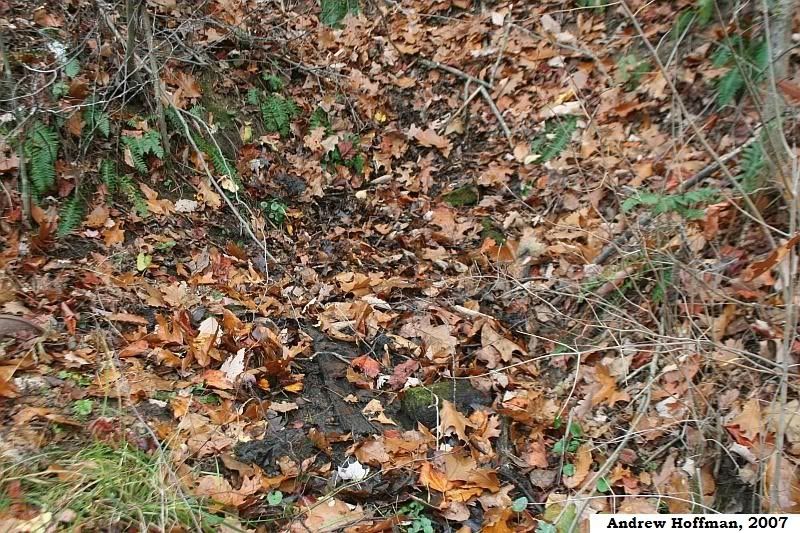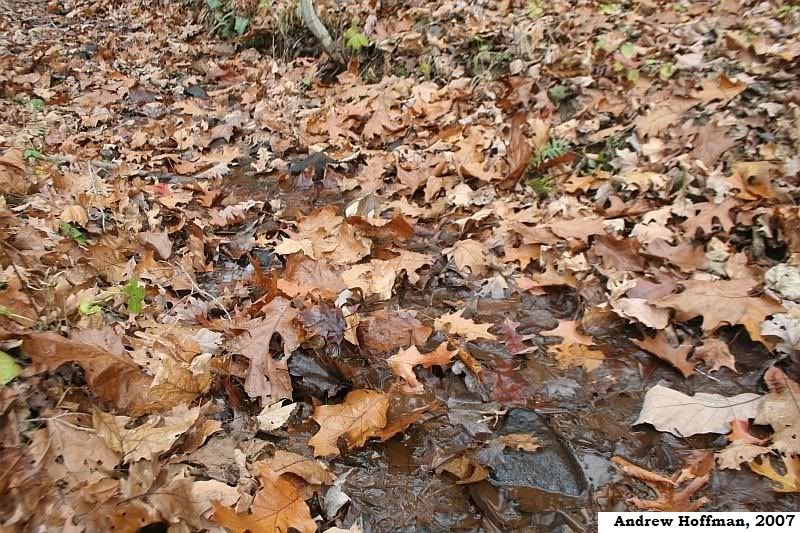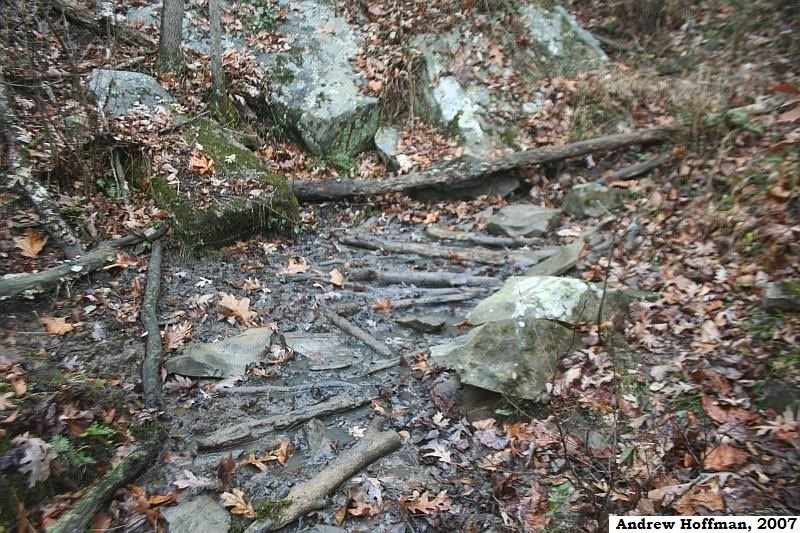Andrew Hoffman
New member
Hi everybody, I was referred to this forum by my friend Mike Graziano just recently and from what I've seen it seems like a great place. I'm an avid field herper and appreciate herps of all kinds, but I've noticed that sals often take a backseat to snakes as far as field herping goes so I'm glad to find a place to post where everybody shares my enthusiasm for salamanders. I thought it would be appropriate to post some recent outings to southern Ohio with Mike so here it goes...
Around Thanksgiving time I got a call from Mike who said he would be back in Ohio for a while so I thought it would be a great time to try a little late season herping. It was late November and winter had finally begun to set in. In southern Indiana and Ohio the temperatures had been dipping down close to freezing every now and then, but with the weather forcast in the 50's (farenheit) with rain over the weekend we decided to give it a go. Our goal was to find southern Ohio's 3 large orange/red Plethodontids (Gyrinophilus porphyriticus, Pseudotriton ruber, and Pseudotriton montanus). Mike told me that all 3 were difficult to find compared to other Plethodontid species even in good spring weather so finding them this late in the year would be tough. The first site we stopped at was one of Mike's spots for Red Salamanders, which he deemed the most unpredictable of the 3 species to find. After a few hours of driving we found ourselves walking around a small creek toward a nice seep that was rather hidden by the thick bed of fallen leaves.

We began searching the muck of the seep for any sign of life. Under a large piece of wood, some small larvae squirmed in the muck. They turned out to be larval P. ruber.

We continued sorting through the muck and leaves, careful to always place cover objects back after checking them. A couple large rocks at the part of the seep that bubbled up looked promising so we lifted the first...nothing. Then the second...I see Mike quickly grab into the muck and after a little digging around he pulls this beauty out.








-Andrew
Around Thanksgiving time I got a call from Mike who said he would be back in Ohio for a while so I thought it would be a great time to try a little late season herping. It was late November and winter had finally begun to set in. In southern Indiana and Ohio the temperatures had been dipping down close to freezing every now and then, but with the weather forcast in the 50's (farenheit) with rain over the weekend we decided to give it a go. Our goal was to find southern Ohio's 3 large orange/red Plethodontids (Gyrinophilus porphyriticus, Pseudotriton ruber, and Pseudotriton montanus). Mike told me that all 3 were difficult to find compared to other Plethodontid species even in good spring weather so finding them this late in the year would be tough. The first site we stopped at was one of Mike's spots for Red Salamanders, which he deemed the most unpredictable of the 3 species to find. After a few hours of driving we found ourselves walking around a small creek toward a nice seep that was rather hidden by the thick bed of fallen leaves.

We began searching the muck of the seep for any sign of life. Under a large piece of wood, some small larvae squirmed in the muck. They turned out to be larval P. ruber.

We continued sorting through the muck and leaves, careful to always place cover objects back after checking them. A couple large rocks at the part of the seep that bubbled up looked promising so we lifted the first...nothing. Then the second...I see Mike quickly grab into the muck and after a little digging around he pulls this beauty out.

We were both exhilerated with such luck so early in our search so we moved on to a nearby stream where we continued finding larvae along with a few Southern Two-lined Salamanders (Eurycea cirrigera) and Northern Dusky Salamanders (Desmognathus fuscus). We were soon off to our second site which contained some slightly different environs. We were searching another one of Mike's seeps but this one transitioned into a nice mucky ditch with about a foot of depth to it.

It wasn't long before we began turning up more larval Pseudotriton, but this time Mike had a hunch it was a different species. Sure enough Mike turned up an older larvae that confirmed his suspicion.

This was my first Mud Salamander and it was exciting to know that we were in the right habitat for them. Their name really does hold true as they often seem to be found in the muckiest muddiest places imagineable. I could watch my entire arm and then shoulder vanish into the mud at many of these sites. We searched hard as the rain began spitting, but then the drizzle turned into a downpour and we took a mad dash to stash the camera gear under the bank of a nearby rocky creek. We avoided much of the rain by staying under the hemlock trees, but while in the creek, Mike informed me that this creek had Gyrinophilus so with the prospect of finding our 3rd target I began flipping rocks. In the shallows I flipped this goreous larval Spring Salamander.

We had now found all 3 of the species we had hoped to see, but we were truly interested in photographing the adults which was in fact the more difficult goal. After more flipping and muck searching we gave up on that site and headed out to search more areas. We decided to concentrate on Spring Sals for awhile, but were very dissapointed to find that the summer and fall drought was still showing its effects as nearly every creek we checked was dry, save for a few small puddles. This, of course, did not bode well for us having luck with salamanders so as the sun began to get lower in the sky we decided to check one last seep for Mud Salamanders. As we walked along a nice rocky creek we came to the spot where the seep flowed into the creek. We began to follow it up to one of Mike's best spots for P. montanus but were saddened by the sight we saw. The site has unfortunately become a well known one and as a result the mud has become hardened where people have raked through it with potatoe rakes, leaving rocks and logs misplaced. We thought our chances were shot, but decided to turn a couple of rocks all the same. I suddenly heard Mike yell out that he had found one and I ran over just in time to see the gorgeous bright orange salamander we had come to see. This was by far one of the prettiest salamanders I have ever seen and I will never forget that sight.


After letting this beautiful fellow go, we opted to not turn any more cover or search the seep as it has suffered far to much disturbance as it was. That salamander that we found did give us hope that the site could still hang on though. By the time we reached the car, we realized we had 45mins to an hour left of daylight so we began evaluating our options. We decided to make a final mad dash for an adult Gyrinophilus, so we headed to a spring that Mike knew of that would have water regardless of the time of year. The only problem was the hike from our car to the spring would be a rugged one that could take quite a while. So by the time we reached the parking area, we decided to bring along flashlights and just make a mad dash to get to the spring. So we ran all the way to the seep and got there just as dark was setting in. With just enough light to see the rocks and any colorful animals that might be under them, we began turning rocks at the seep, which surprisingly had little water...but it had enough. After a few Dusky Salamanders I turned what seemed like the last rock in the seep to see something shocking. Out of a hole peered another bright orange Mud Salamander! Even more surprising, was the fact that it first retreated into its burrow (as expected) but then proceded to launch its self out and make a mad dash for who knows where. This of course made it easy to snag for photos.

It was not what we had hoped for, but in a way it was even better as Mud Salamanders were not known from that particular spring. As I photographed this guy, the rain once again began to drop and then pour. We walked back in a torrential downpour and complete darkness, which prompted Mike to bring up the option of road cruising. I never imagined road cruising at night in late November, but with the temperature staying in the 50's and such a heavy rain it certainly didn't seem out of the question. So we opted to get back a little later and give our final target one last go. Mike had had much success with road cruising up Spring Salamanders so we were hopeful still. Worms began to make things difficult as did funny shaped leaves and sticks so after a good hour or so we had begun winding our way back toward the main highway with no luck. As we rounded one of the last bends before climbing up and out of the valley and away from the creek, I heard Mike exclaim "hey thay looked like a salamander...maybe a Gyro". I figured it was just wishful thinking, but stopped just to humor him. He ran back and began looking closer to the road as I backed up the car. Sure enough we were soon looking right at a perfect ending to what was probably my best day ever of winter salamandering.

After many worms, one of them finally turned out to be a beautiful Kentucky Spring Salamander. This was only Mike's second time ever to find all 3 species in one day and accomplishing this in the winter months was really great. The drive home was filled with lots of reflections from the day and wishes that we had more time to road cruise. In the end it was good that we had not stayed an extra day as the temperature dropped down to freezing the following day. I will post a follow up soon, but I hope you all enjoyed this one and I can't wait to see everyone else's field herping posts.
-Andrew
